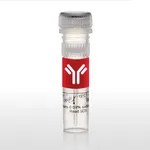Thermo Fisher Scientific MCL-1 Monoclonal Antibody (LVUBKM), Alexa Fluor 488, eBioscience
다른 상품 둘러보기
Applications
Tested Dilution
Publications
Flow Cytometry (Flow)
5 µL (0.125 µg)/test
View 1 publication 1 publication
Product Specifications
Published species
Human
Host/Isotype
Mouse / IgG1, kappa
Recommended Isotype Control
Mouse IgG1 kappa Isotype Control (P3.6.2.8.1), Alexa Fluor™ 488, eBioscience™
Class
Monoclonal
Type
Antibody
Clone
LVUBKM
Conjugate
Alexa Fluor™ 488 Alexa Fluor™ 488 Alexa Fluor™ 488
View additional formats
Excitation/Emission Max
499/520 nm View spectra 
Form
Liquid
Concentration
5 µL/Test
Storage conditions
4° C, store in dark, DO NOT FREEZE!
Shipping conditions
Wet ice
RRID
AB_2574438
Product Specific Information
Description: This LVUBKM monoclonal antibody recognizes human and mouse myeloid cell leukemia sequence 1 (Mcl-1). Mcl-1 is an anti-apoptotic member of the Bcl-2 family of proteins important for regulation of cell survival/apoptosis. Mcl-1 is primarily localized to the outer membrane of mitochondria where it prevents cytochrome c release via dimerization with other Bcl-2 family members such as Bim. Although it is expressed in both immune and non-immune cells, highest levels of Mcl-1 expression are seen in hematopoietic lineage cells. PI3K activation of AKT results in destabilization and degradation of GSK3 beta, which prevents phosphorylation of Mcl-1 on S159 and its subsequent ubiquitination and degradation. Mice conditionally lacking Mcl-1 in lymphocytes showed that Mcl-1 is essential during early lymphoid development and for the maintenance of mature lymphocytes.
Applications Reported:This LVUBKM antibody has been reported for use in intracellular staining followed by flow cytometric analysis.
Applications Tested: This LVUBKM antibody has been pre-titrated and tested by intracellular staining followed by flow cytometric analysis of normal human peripheral blood cells. This can be used at 5 µL (0.125 µg) per test. A test is defined as the amount (µg) of antibody that will stain a cell sample in a final volume of 100 µL. Cell number should be determined empirically but can range from 10^5 to 10^8 cells/test.
Staining Protocol: All protocols work well for this monoclonal antibody. Use of Protocol A: Two-step protocol: intracellular (cytoplasmic) proteins allows for the greatest flexibility for detection of surface and intracellular (cytoplasmic) proteins. Use of Protocol B: One-step protocol: intracellular (nuclear) proteins is recommended for staining of transcription factors in conjunction with surface and phosphorylated intracellular (cytoplasmic) proteins. Protocol C: Two-step protocol: Fixation/Methanol allows for the greatest discrimination of phospho-specific signaling between unstimulated and stimulated samples, but with limitations on the ability to stain specific surface proteins (refer to Clone Performance Following Fixation/Permeabilization located in the BestProtocols Section under the Resources tab online). All Protocols can be found in the Flow Cytometry Protocols: Staining Intracellular Antigens for Flow Cytometry Protocol located in the BestProtocols® Section under the Resources tab online.
Excitation: 488 nm; Emission: 519 nm; Laser: Blue Laser.
Filtration: 0.2 µm post-manufacturing filtered.
Target Information
MCL1 (Myeloid cell leukemia-1) belongs to the Bcl-2 family and is involved in programing, differentiation and concomitant maintenance of cell viability, but not of proliferation. Isoform 1 of MCL1 inhibits apoptosis while isoform 2 promotes it. The carboxy terminal of MCL1 and bcl-2 share significant sequence homology. Expression of MCL1 is increased upon exposure of ML-1 cells to various types of DNA damaging agents (e.g. ionizing radiation, ultraviolet radiation, and alkylating drugs) along with increases in GADD45 and Bax and a decrease in bcl-2. Enhanced expression of MCL1, prominently associated with mitochondria, complements the continued expression of bcl-2 in ML-1 cells undergoing differentiation. Like bcl-2, MCL1 has the capacity to promote cell viability under conditions that otherwise cause apoptosis. While the mechanism by which MCL1 inhibits apoptosis is not known, it is thought that it may heterodimerize and neutralize pro-apoptotic members of the Bcl-2 family such as Bim or Bak. MCL1 was originally identified in differentiating myeloid cells, but has since been shown to be expressed in multiple cell types. MCL1 is essential for embryogenesis and for the development and maintenance of B and T lymphocytes in animals. MCL1 exists as at least two distinct isoforms designated MCL1L and MCL1S. In marked contrast to the larger isoform of MCL1, overexpression of MCL1S promotes cell death.
For Research Use Only. Not for use in diagnostic procedures. Not for resale without express authorization.
배송/결제/교환/반품 안내
배송 정보
| 기본 배송비 |
| 교환/반품 배송비 |
|
|---|---|---|---|
| 착불 배송비 |
| ||
| 교환/반품 배송비 |
| ||
결제 및 환불 안내
| 결제수단 |
|
|---|---|
| 취소 |
|
| 반품 |
|
| 환급 |
|
교환 및 반품 접수
| 교환 및 반품 접수 기한 |
|
|---|---|
| 교환 및 반품 접수가 가능한 경우 |
|
| 교환 및 반품 접수가 불가능한 경우 |
|
교환 및 반품 신청
| 교환 절차 |
|
|---|---|
| 반품 절차 |
|

